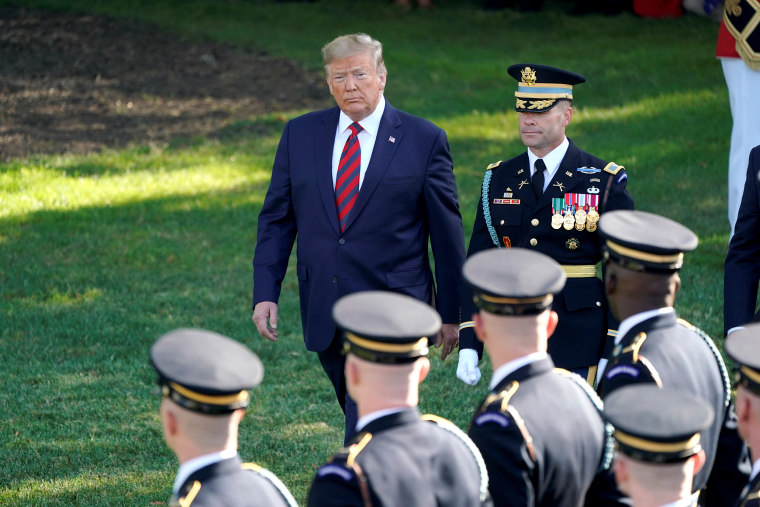The Office of the U.S. Trade Representative announced that it is granting tariff exemptions to more than 400 items imported from China. According to trade experts, the move indicates that the trade war is inflicting increasing harm to American industries and consumers — and that the White House is trying to mitigate that damage and lower tensions as negotiators from the two countries try to work out a deal.
President Donald Trump acknowledged Friday that he and his Chinese counterpart, President Xi Jinping, were having "a little spat," but noted that a deal was not necessary before the 2020 U.S. presidential election.
“The timing of this is important because there seems to be at least a little movement in the direction of ramping down tensions,” said Michael O. Moore, a professor of economics and international affairs at George Washington University. “If you’re trying to make a deal, this makes perfect sense.”
The exemptions were on goods in three separate tranches of tariffs the U.S. imposed between July 6 and Sept. 24, 2018 that total $250 billion worth of imports. All three are temporary, with the exemptions on the $200 billion portion expiring Aug. 7, 2020, with the other two sets of exemptions expiring one year from now. U.S. business interests had requested tariff exclusions for these items on the primary grounds that they either could not get that particular item from a U.S. producer or a third country, or that it would be prohibitively expensive to do so.
Moore said the variety of items on the list reflected the global nature of today’s supply chains, and the wide breadth of the U.S.-China trade relationship. “The two economies are intertwined after 30 years of intense commercial buildup,” he said.
Altogether, the 437 types of goods receiving exemptions comprise a diverse list of consumer goods as well as parts, raw materials, components and production equipment for industries ranging from construction to healthcare to mining. The eclectic nature of the list reflects, in part, which industries were most successful at lobbying the USTR to issue exemptions on goods important to their businesses.
There were a number of consumer products among the listed items: dog harnesses, retractable leashes, GPS collars and pet drinking fountains. Also exempted were several items related to outdoor leisure and hobbies: Off-road ATVs, single-speed bikes and electric skateboards, along with pool vacuum parts and thermometers, coolers, portable ice-cube makers, steel wire barbecue grill tops, patio torches, and some metal pergolas and gazebos.
Since most of the initial tranches of tariffs sought to avoid consumer goods in favor of industrial components or inputs, the bulk of the list reflects that, including a large number of car and airplane parts, airport conveyor belts, circuit boards, several types of plastic film, sheeting and coated textiles.
Although the restaurant and hotel industry has been shying away from single-use plastics, standard-sized plastic drinking straws were exempted from the tariffs, along with the plastic cups used to make single-serve coffee pods. Hospitality businesses that are trying greener alternatives also get some relief, though; machines for manufacturing paper straws were on the list as well.
Some of the items reflect the extent of the tariffs’ impact on the construction and homebuilding industries. Exemptions were granted on certain kinds of wood-laminate flooring, equipment used to produce engineered quartz countertops, bulldozers, forklifts, portable concrete mixers, chain-link fencing, woodworking tools and equipment.
The much-beleaguered agricultural sector got some relief due to exemptions on feeding troughs, machines and enclosures for livestock. “The pressure on U.S. farmers is intense because of the Chinese retaliatory tariffs,” Moore said. “I think the administration’s trying desperately to reduce the pressure.”
The list also illustrated the degree to which the healthcare industry is dependent on Chinese imports. It included parts for MRI and X-ray machines, surgical implements like cauterization tools, masks, electrodes, scopes and respiration meters.
“Medical products generally have very strict procedures on what is allowed to be used and imported into the United States. That means it’s difficult to move production to another country,” Moore said, adding that driving up Americans’ already-high healthcare costs would be detrimental all around. “That could have very bad outcomes.”
Moore said the medical category is a good example of what this list illustrates in a broader sense: That President Donald Trump’s goal of bringing manufacturing back to the U.S. is unlikely to succeed. “It’s clearly a recognition that the tariffs aren’t helping U.S. firms,” he said. “Production would move to other countries other than the United States.”
In today’s global economy, Moore said, “A firm’s choices are not just the United States or China.”
